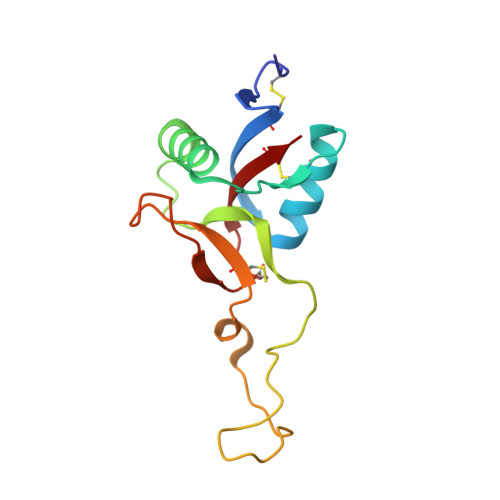pH-Dependent Structural Changes at Ca(2+)-binding sites of Coagulation Factor IX-binding Protein
Suzuki, N., Fujimoto, Z., Morita, T., Fukamizu, A., Mizuno, H.(2005) J Mol Biol 353: 80-87
- PubMed: 16165155
- DOI: https://doi.org/10.1016/j.jmb.2005.08.018
- Primary Citation of Related Structures:
1X2T, 1X2W - PubMed Abstract:
Coagulation factor IX-binding protein, isolated from Trimeresurus flavoviridis (IX-bp), is a C-type lectin-like protein. It is an anticoagulant consisting of homologous subunits, A and B. Each subunit has a Ca(2+)-binding site with a unique affinity (K(d) values of 14muM and 130muM at pH 7.5). These binding characteristics are pH-dependent and, under acidic conditions, the Ca(2+) binding of the low-affinity site was reduced considerably. In order to identify which site has high affinity and to investigate the pH-dependent Ca(2+) release mechanism, we have determined the crystal structures of IX-bp at pH 6.5 and pH 4.6 (apo form), and compared the Ca(2+)-binding sites with each other and with those of the solved structures under alkaline conditions; pH 7.8 and pH 8.0 (complexed form). At pH 6.5, Glu43 in the Ca(2+)-binding site of subunit A displayed two conformations. One (minor) is that in the alkaline state, and the other (major) is that at pH 4.6. However, the corresponding Gln43 residue of subunit B is in only a single conformation, which is almost identical with that in the alkaline state. At pH 4.6, Glu43 of subunit A adopts a conformation similar to that of the major conformer observed at pH 6.5, while Gln43 of subunit B assumes a new conformation, and both Ca(2+) positions are occupied by water molecules. These results showed that Glu43 of subunit A is much more sensitive to protonation than Gln43 of subunit B, and the conformational change of Glu43 occurs around pH6.5, which may correspond to the step of Ca(2+) release.
Organizational Affiliation:
Department of Biochemistry, National Institute of Agrobiological Sciences, Tsukuba, Ibaraki 305-8602, Japan.


















